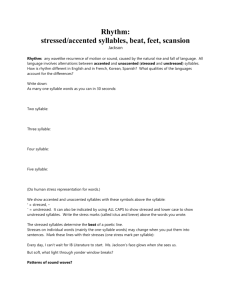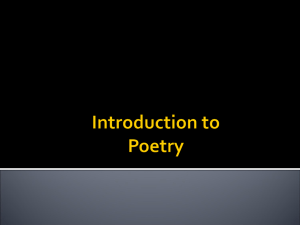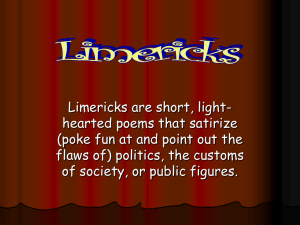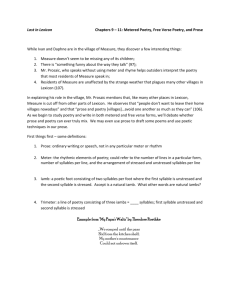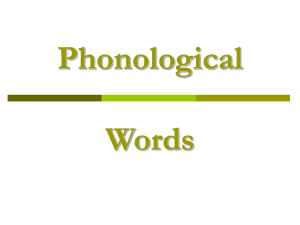3) Poetry workshop 3
advertisement
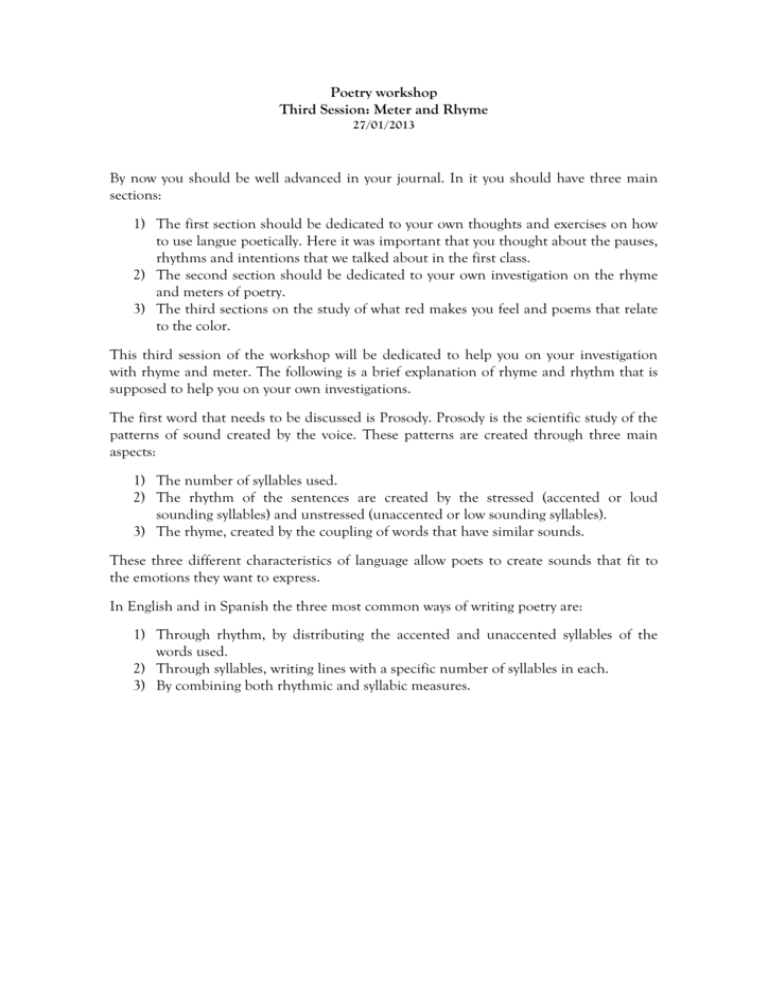
Poetry workshop Third Session: Meter and Rhyme 27/01/2013 By now you should be well advanced in your journal. In it you should have three main sections: 1) The first section should be dedicated to your own thoughts and exercises on how to use langue poetically. Here it was important that you thought about the pauses, rhythms and intentions that we talked about in the first class. 2) The second section should be dedicated to your own investigation on the rhyme and meters of poetry. 3) The third sections on the study of what red makes you feel and poems that relate to the color. This third session of the workshop will be dedicated to help you on your investigation with rhyme and meter. The following is a brief explanation of rhyme and rhythm that is supposed to help you on your own investigations. The first word that needs to be discussed is Prosody. Prosody is the scientific study of the patterns of sound created by the voice. These patterns are created through three main aspects: 1) The number of syllables used. 2) The rhythm of the sentences are created by the stressed (accented or loud sounding syllables) and unstressed (unaccented or low sounding syllables). 3) The rhyme, created by the coupling of words that have similar sounds. These three different characteristics of language allow poets to create sounds that fit to the emotions they want to express. In English and in Spanish the three most common ways of writing poetry are: 1) Through rhythm, by distributing the accented and unaccented syllables of the words used. 2) Through syllables, writing lines with a specific number of syllables in each. 3) By combining both rhythmic and syllabic measures. Rhythmic poetry There are a few important things to know about rhythmic poetry. As we mentioned before it is created by the patterns that can be made through unstressed and stressed syllables. In formal terms the unstressed syllable is written (˘) and the stressed is written. (/ ). In this way, if you see for example, the following map: / ˘ / ˘ / ˘ / ˘ Tyger! Tyger! burning bright The (/) on top of the first syllable of Tyger signals the stressed and loud sound of the syllable. The (˘) on top of the second syllable of Tyger signals the unstressed and low sound of the syllable Within the study of rhythm, there are many different combinations. The most common combinations are based on disyllables (two syllables) or trisyllabals (three syllables). The disyllable meters are: Iambi: It consists of one unstressed syllable and one stresses syllable (˘ /) Trochee: It consists of one stresses syllable and one unstressed syllable (/˘) Spondee: It consists of two accented syllables (//) Pyrrhic: It consists of two unaccented syllables. In formal terms it is written (˘˘). Most commonly the pyrrhic is used with other metric combinations. Be near me when my light is low, When the blood creeps, and the nerves prick And tingle; and the heart is sick, And all the wheels of Being slow. The trisyllable meters are: Dactyl: It consists of one accented syllable and two unaccented (/˘˘) Anapest: It consists of two unaccented sylablles and one accented (˘˘/) Cretic: It consists of one accented one unaccented and one accented (/˘/) Amphibrac: It consists of one unaccented, one accented and one unaccented (˘/˘) (Note: In your research it is important that you find at least one example of the different types of rhythmic patterns shown here.) 2 Syllabic poetry Syllabic poetry is one of the easiest ways to write poetry. It simply consists of counting the syllables that are used on each line. The most common example of syllabic poetry is the haiku, which is a poem made of three lines. The fist of five syllables, the second of seven and the third of five. Example: An old silent pond... A frog jumps into the pond, splash! Silence again. Rhyme in poetry Rhyme is a repetition of similar sounds on two or more words, most often at the end of lines. The two main types of rhyme are separated into two groups: Masculine rhymes, which are rhymes in that have the similar sound in the last syllable. Example: Rhyme and Sublime. Feminine rhymes, which are rhymes that have the similar sound on the penultimate syllable. Example: Picky and Tricky. (Note: In your research it is important that you find at least one example of the two different types of rhymes.) Homework for the fourth session on February 7 For the following session you need to bring your poetry notebooks with the following information: -At least five pages of research on prosody. -At least 8 poems that you have liked and studied. For each of the poems you choose you have to see what types of structure it has. Is it syllabical, rhythmic or both? -At least 10 pages with reflections of your own. This may be poems that you have written or reflections about emotions that are connected with the color red. Also you have to send an email to diego.pt@ameyalli.edu.mx confirming that you have got the two documents that have been sent to you. For any questions you can write to: diego.pt@ameyalli.edu.mx 3 4
